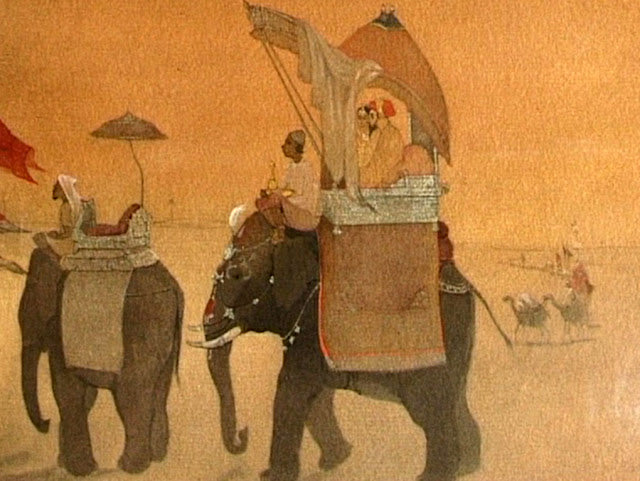Description
The painting "march from Emperor to Kashmira" ("Emperor's March to Kashmir"), although sometimes attributed to Gaganendranath Tagore, is actually the work of his brother Abanindranath Tagore, a prominent figure in the artistic movement known as the Bengal Renaissance. This movement sought to revive and modernize Indian artistic traditions by merging them with Western and Japanese influences.
The work "Marcha of the Emperor to Kashmir" encapsulates this stylistic and cultural fusion through its composition and choice of theme. In the painting, the artist presents a historical scene that recalls a glorious and monumental past, possibly evoking an imperial march. This type of scenes was common in Abanindranath's work, who often sought to be inspired by the history and mythology of India to create epic and resonant images.
A meticulous observation of the compositional aspects of the painting reveals a subtle juxtaposition between traditional pictorial resources and modern influences. The use of the color of the Emperor to Kashmir "is remarkable for its softness and restricted palette, which focuses on earth and gold tones. This chromatic approach not only adds depth and dimension, but also establishes an almost dreamlike atmosphere that suggests at the same time realism and fantasy.
Among the most prominent elements of this work are human figures, which are represented in detail and extremely expressive. In the foreground, we can observe the emperor mounted in a splendid white horse, imbued with majesty and serenity, moving solemnly. Surrounding the emperor, a series of companions, perhaps noble and warriors, march in formation, all dressed in lavish clothes that shine under the golden light. These figures, although clearly stylized, have a convincing dynamism and movement that denote Tagore's ability to combine detailed representation with an epic sense of greatness.
The surrounding landscape and the architecture represented in the painting also deserve attention. The lines and shapes of trees, mountains and buildings suggest an influence of Japanese landscape techniques, while architectural details allude to the greatness of Palacios and temples Mogoles. This amalgam of influences creates a rich visual narrative that speaks of both the particular place that it represents and the idealism and nostalgia of Tagore by a golden era of Indian civilization.
It is also important to recognize the historical and cultural context in which Abanindranath Tagore produced this work. At the beginning of the 20th century, India was in a period of agitation and change, seeking its identity against British colonial domination. Tagore's art should not only be seen as an aesthetic response to these conditions, but also as an act of cultural resistance, an identity statement through the recovery and celebration of Indian history.
In summary, "Emperor A Kashmiro" is erected not only as an excellent piece of the Abanindranath Tagore artistic repertoire, but also as a visual testimony of the crossing of influences and the search for cultural identity. The careful balance between tradition and modernity in the work creates a composition that is, at the same time, evocative and majestic, revealing of the genius of Tagore and the wealth of the Bengal Renaissance.
KUADROS ©, a famous paint on your wall.
Hand-made oil painting reproductions, with the quality of professional artists and the distinctive seal of KUADROS ©.
Art reproduction service with satisfaction guarantee. If you are not completely satisfied with the replica of your painting, we refund your money 100%.

